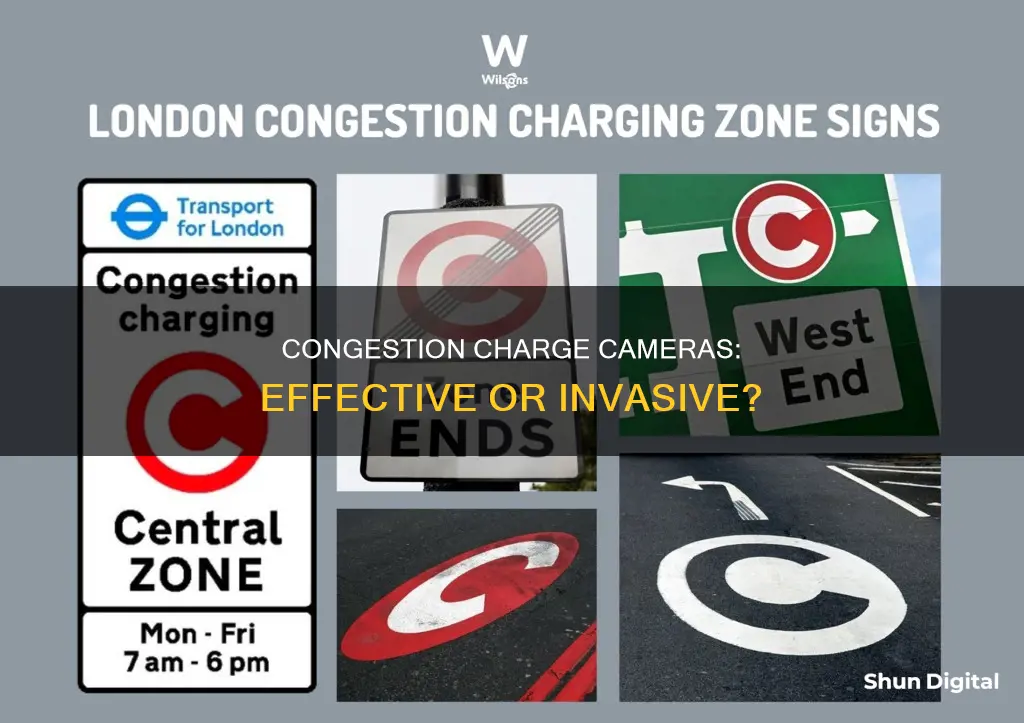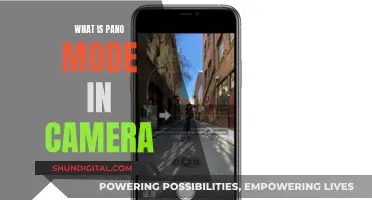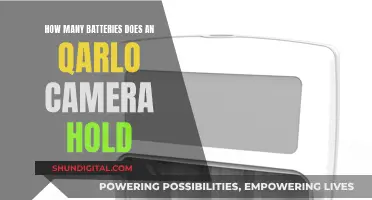
Congestion charge cameras are an effective way to monitor traffic and enforce congestion charges in cities. In London, for example, Transport for London (TfL) uses a network of cameras and automatic number plate recognition (ANPR) technology to monitor vehicles entering and exiting congestion charge zones. The cameras capture images of traffic and send them to a central processor to read and check number plates against a list of vehicles that have paid the congestion charge. This helps reduce traffic congestion and raise revenue for public transport improvements. While there are ways to avoid the charges, such as using public transportation or eligible for discounts, the cameras play a crucial role in enforcing the congestion charge and deterring violations.
| Characteristics | Values |
|---|---|
| Number of cameras | 197 |
| Camera type | Fixed |
| Camera technology | Automatic Number Plate Recognition (ANPR) |
| Camera capabilities | Can operate in low light using IR technology and provide images in both colour and black and white |
| Camera locations | Every entrance and exit from the Congestion Charge zone, with a black and white camera for each lane of traffic and a colour camera for an overview of the whole road |
| Camera success rate | 90% |
| Camera maintenance | Relocatable as and when required |
| Number of images processed per day | 1 million |
| Number of fines issued daily | 5,500 |
| Number of vehicles entering the zone per hour | 40,000 |
| Reduction in traffic | 20% |
| Revenue raised | £130-150 million per year |
What You'll Learn

Congestion charge cameras and their effectiveness in London
Congestion charge cameras in London are enforced by fixed cameras, which are placed at every entrance and exit from the Congestion Charge zone. These cameras are equipped with Automatic Number Plate Recognition (ANPR) technology, which reads and checks number plates against a list of vehicles that have paid for access. The cameras are also able to operate in low light using IR technology and can provide images in both colour and black and white.
The Congestion Charge zone covers Central London, including most parts of Westminster and the City of London. The zone operates Monday to Friday between 7 am and 10 pm and is occasionally suspended at the discretion of the Mayor. The charge is £15 per day and can be paid online, by phone, text message, post, or using the TfL "CC AutoPay" scheme.
The effectiveness of the Congestion Charge scheme in London has been debated. The scheme was introduced in 2003 by then-Mayor of London, Ken Livingstone, with the aim of reducing traffic congestion in the city centre and encouraging the use of public transport. Since its introduction, the scheme has reduced traffic in central London by 20%, with 70,000 fewer vehicles entering the charging zone each day compared to before the scheme was implemented. The scheme has also raised approximately £150 million per year, which has been used to improve public transport in London.
However, the Congestion Charge scheme has also faced criticism and controversy. Some have argued that the cost of running the ANPR camera system is high, with the Chairman of the West London Residents Association (WLRA) stating that it is "nearly 50 times that of a similar-sized Tag and Beacon system in Singapore". There have also been concerns about the privacy implications of the cameras and the potential for misuse of the data collected. Despite these criticisms, the Congestion Charge scheme has been generally effective in reducing traffic congestion and raising revenue for public transport improvements in London.
Charging the Fuji XT-30: A Quick Guide
You may want to see also

The impact of congestion charge cameras on traffic
The congestion charge, implemented in 2003, applies to most vehicles entering London's Congestion Charge Zone during specified hours. The aim was to reduce traffic congestion and encourage the use of public transportation. The scheme has been controversial, with some doubting its effectiveness, but it has achieved its goals of reducing traffic and raising funds for public transport improvements.
Congestion charge cameras play a crucial role in enforcing the scheme. These cameras, equipped with Automatic Number Plate Recognition (ANPR) technology, are positioned at entry and exit points to the charging zone and at strategic locations within the zone. They capture images of vehicle number plates, which are then checked against a database to verify payment or eligibility for discounts or exemptions. The cameras operate effectively in various lighting conditions and can capture plates even in bumper-to-bumper traffic.
The success of the congestion charge cameras in London has led to similar initiatives in other cities, such as the Ultra Low Emission Zone (ULEZ) expansion, which aims to create a greener city by charging vehicles that do not meet emission standards. However, the implementation of such schemes has also faced opposition and vandalism of the cameras by those who disagree with the charges.
Overall, congestion charge cameras have proven to be an effective tool in managing traffic and reducing congestion in London. By providing a financial disincentive to driving in the city centre, the cameras have played a key role in achieving the desired reduction in traffic, ultimately improving the flow of traffic and making the city more pedestrian-friendly.
Charging the Noorio Camera: A Quick Guide
You may want to see also

The cost of congestion charge cameras
In London, the congestion charging scheme has been modified and extended several times since its introduction in 2003, requiring ongoing investment in new camera systems and updates to the supporting technology infrastructure. For example, the western extension of the London congestion zone in 2007 required a new contract for ANPR cameras, worth more than $9 million.
The annual running cost of the London congestion charge scheme is estimated to be £50 million, with the scheme raising around £130-150 million per year in revenue. This revenue is used to improve public transport in London, which was one of the key aims of the scheme.
In addition to the direct costs of the camera systems and technology infrastructure, there are also enforcement costs associated with congestion charging schemes. In London, this includes the use of mobile camera vans at undisclosed locations, as well as the cost of processing penalty charge notices for vehicles that fail to pay the charge.
Charging Your GoPro Ultra HD Camera: A Step-by-Step Guide
You may want to see also

The impact of congestion charge cameras on revenue
Congestion charge cameras have had a significant impact on revenue in cities that have implemented them. In London, for example, the congestion charging scheme has raised approximately £130-150 million per year, with around one-third of that amount coming from fines. This revenue has been crucial in funding public transport improvements, contributing to a more sustainable and efficient transportation system in the city.
The effectiveness of congestion charge cameras in generating revenue is evident in their ability to capture vehicle information accurately. The cameras, equipped with Automatic Number Plate Recognition (ANPR) technology, capture images of vehicles entering and exiting the congestion charge zone. These images are then processed to identify the registered users of the vehicles, enabling the issuance of charges or fines. This technology ensures that vehicles are accurately tracked and billed, maximizing revenue collection.
Moreover, the revenue impact of congestion charge cameras is influenced by the level of charges and fines imposed. In London, the daily congestion charge is £15, and failure to pay on time results in a higher charge of £17.50 and subsequent fines of up to £130. The penalty charge notice (PCN) system, with its escalating fees, acts as a deterrent and encourages timely payment. The combination of charges and fines contributes significantly to the overall revenue generated from the congestion charge scheme.
While congestion charge cameras have been effective in boosting revenue, it is important to consider their broader impact on transportation behavior. The congestion charging scheme in London has successfully reduced traffic by around 20%, indicating a shift towards alternative modes of transportation or a reduction in non-essential travel. This reduction in traffic has likely led to a decrease in revenue from other sources, such as parking fees, as fewer vehicles are entering the city center. Therefore, while congestion charge cameras have a positive impact on revenue from charges and fines, they may also influence other revenue streams, resulting in a complex overall financial impact.
Charging Your SimpliSafe Outdoor Camera: A Quick Guide
You may want to see also

The public perception of congestion charge cameras
On the one hand, congestion charge cameras have been credited with reducing traffic congestion and improving traffic flow in cities like London and New York. In London, for example, the congestion charging scheme has resulted in a 20% reduction in traffic entering the city centre during charging hours. This has led to an increase in the use of public transportation and a boost in revenue for public transport improvements.
However, the introduction of congestion charge cameras has also sparked opposition and controversy. Some people argue that the cameras are an invasion of privacy and a form of government surveillance. There are also concerns about the cost of the camera systems and the potential for errors or abuse of the data collected. In London, for instance, the congestion charge zone has been controversial since its introduction in 2003, with some people criticising it as a tax on motorists.
To address privacy concerns, congestion charge camera systems typically use Automatic Number Plate Recognition (ANPR) technology, which focuses solely on capturing images of vehicle registration plates. These images are then processed to identify vehicles that have not paid the congestion charge. The images of vehicles that have paid the charge are usually deleted from the system.
Additionally, some cities have implemented measures to minimise the impact of congestion charge cameras on residents and commuters. For example, in London, residents within the congestion charge zone are offered discounts, and certain types of vehicles, such as electric cars and emergency service vehicles, are exempt from the charge.
Overall, while congestion charge cameras have proven effective in reducing traffic congestion and improving traffic flow, there are ongoing debates about the ethical implications, cost, and impact on residents and commuters. The balance between addressing traffic congestion and preserving privacy remains a challenging issue for cities implementing such systems.
Abode Streaming Camera: Charging and Power Options
You may want to see also
Frequently asked questions
Congestion charge cameras use Automatic Number Plate Recognition (ANPR) technology to capture images of traffic and send them to a central processor to read and check number plates against a list of vehicles that have paid the charge.
Congestion charge cameras are placed at every entrance and exit of the Congestion Charge Zone, with a black-and-white camera for each lane of traffic to capture registration plates, and a colour camera to record an overview. There are also additional cameras at strategic points within the zone and mobile camera vans at undisclosed locations.
Congestion charge cameras have been shown to be effective in reducing traffic and raising revenue for public transport improvements. In Central London, the congestion charging scheme reduced traffic by 20%, with 70,000 fewer vehicles entering the charging zone daily. The scheme also raises approximately £130-150 million per year.
While it is technically possible to avoid congestion charge cameras by changing lanes or tailgating large vehicles, it is extremely difficult given the number of cameras and volume of traffic.
One alternative to congestion charge cameras is the 'Tag and Beacon' system, where cars have an electronic tag on the windscreen that emits a radio signal when passing a roadside beacon, automatically paying the charge. This system is much cheaper to run but would significantly reduce fine revenue.







